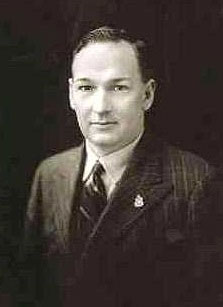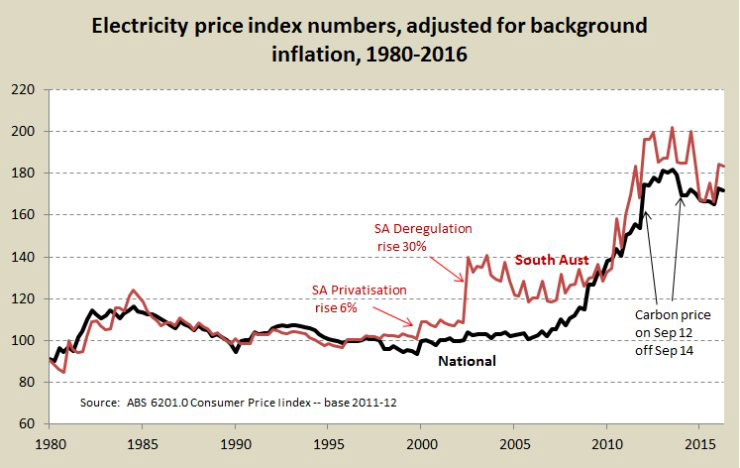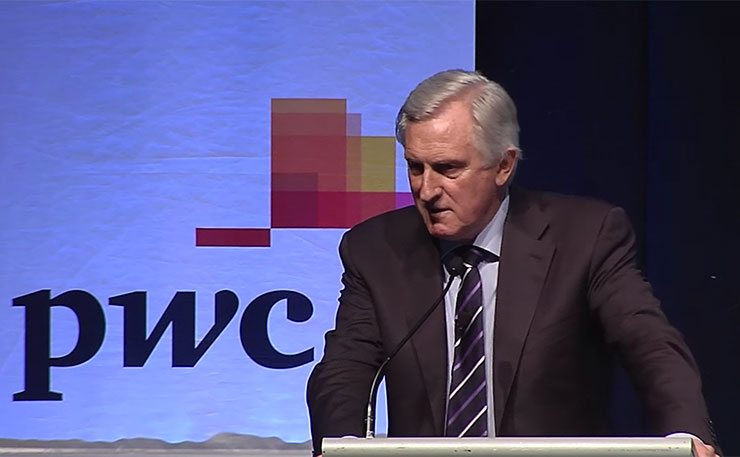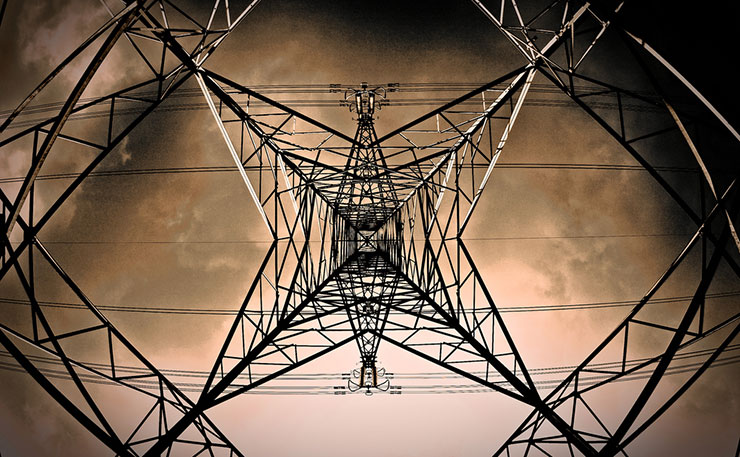New Matilda economics writer Ian McAuley adds his voice to those calling for a bipartisan approach to energy policy.
Spare a thought for the people of South Australia. Large parts of Adelaide blacked out for up to 18 hours without notice. Trams stopped in their tracks across busy intersections. A bitter and partisan debate in state parliament about responsibility for the chaos – the electricity supplier, the federal government, other states putting their own energy needs ahead of South Australia’s? A heated argument about energy sources – coal or alternatives? Firms threatening to shift to other states because of unreliable electricity supply. Bitter complaints from consumers and businesses about electricity prices.
That was in 1946.
In response, Premier Tom Playford steered a bill through parliament to nationalise the British-owned Adelaide Electricity Supply Company.

Playford was no left-winger (although he might be judged as hard left by the standards of 2017). He was from the Liberal and Country League (i.e. the “Coalition”), and in transferring electricity supply to a government business enterprise he was simply following the precedent of other states, which for many years had held electricity in public ownership.
Playford realised that electricity supply was too important to be left to the private sector, and that a well-managed government utility (the Electricity Trust of South Australia – ETSA) could do a far better job than a private company driven by profit-maximising incentives and accountable to foreign owners.
He ignored warnings about a capital strike and a political backlash. South Australia went on to industrialise and prosper and Playford was to remain as premier for another 20 years (with help from favourable electoral boundaries).
Over the fifties, sixties and seventies as Australia’s economy grew there was a big expansion in national electricity generation capacity (coal seemed to be a good idea at the time) which is why so many power stations, with a service life of about 40 years, are now coming to the end of their lives. And until around the end of the century, electricity prices – nationally and in South Australia – were stable or falling in real (inflation-adjusted) terms.
In retrospect it’s clear that electricity was priced at less than its long-term cost because there was inadequate provision for eventual re-investment in these state-owned utilities. Governments are in the habit of taking high dividends from utilities, depriving them of capital.
The clear solution should have been a capital injection from governments, but under the ideology of neoliberalism, and government accounting conventions that allowed most of the proceeds of asset sales to appear as “revenue”, cash-strapped state governments came under increasing pressure to privatise their utilities. South Australia was under particular pressure following the collapse of the State Bank – a classic case study of what happens when a government business utility that once served community interests is put in the hands of profit-maximising cowboys.
So in 1997, the Olsen Liberal Government privatised ETSA, which saw an immediate real electricity price rise of six per cent, and by 2003, in accordance with the rules of what was to become the National Electricity Market (NEM), ETSA had been broken up into four parts – generation, transmission, distribution and retail.
This “structural separation”, as it is called, was not for any reason of efficiency: rather it was to re-shape the electricity supply industry to conform with the “competitive” model described in basic text books. As a result transaction costs (the costs of the four entities dealing with one another) rose strongly, and in South Australia electricity prices rose by a further 30 per cent.
The price aspect of that story is shown in the graph below. Privatisation and structural separation set off price rises – in one big step in South Australia, more slowly in other states. That graph also shows the effect of the short-lived carbon tax, which is no more than a blip at the end, and it is notable that once the tax was repealed in 2014 only about half of the price rise was handed back to consumers.

Privatisation “solved” the underpricing problem, but not much of the extra revenue went into useful expansion of electricity networks. Much went into profits, marketing and executive salaries.
Some of the money went into setting up “retailers” – financial intermediaries whose function is supposed to hedge between volatile spot prices and prices offered to consumers. Almost a quarter of one’s electricity bill goes to support these “retailers” – about the same as is paid to the companies that generate electricity.
The old state-owned vertically-integrated utilities hadn’t needed a separate “retail” function, but having followed the dogma of structural separation, resulting in wild swings in wholesale prices, consumers have been saddled with an expensive bureaucracy to compensate for the volatility of private markets.
The higher prices were also supposed to encourage extra investment in transmission and distribution assets (“poles and wires”), and these companies were regulated as natural monopolies. But the regulators (initially state, later federal), allowed an absurdly high return on capital, which encouraged over-investment in assets, even as demand was starting to flatten (electricity use per capita peaked early in this century).
That over-investment did not help South Australia however, because much of its present vulnerability relates to weak interconnection with other states. Electricity should be delivered over networks that look like road maps, with alternative routes available in case of mishaps. But South Australia’s electricity is delivered essentially along one long line, which is why it is particularly sensitive to disruption by storms and other outages.
The main fault with the NEM, however, is in its basic design. It’s designed as a market, and it operates just as a market is expected to behave. Whenever there is an actual or incipient supply shortage in a market, companies have a commercial incentive to hold back supply to keep prices high. The existence of under-used capacity during two of South Australia’s recent energy crises strongly suggests that such commercial incentives have overridden the NEM’s rules about prioritising supply.
As John Hewson has said, the NEM is a mess, a national embarrassment – something modelled on a British system of 20 years ago, when electricity supply was based on big centralised generators and when renewables and storage were high-cost (what is the cultural cringe, or lack of confidence and imagination, that sends Australian policymakers off to London to look for models of public policy?).

Even if we get through what remains of this summer without bad disruptions, it’s a fair bet that in the next few years, as old coal-fired stations are retired, we will face disruptions in all the NEM states (i.e. all except WA and the NT.)
Australia won’t always have a national government held to ransom by the (heavily subsidised) coal industry and a small handful of climate change deniers. Eventually our electricity future will be renewables and storage. Clever domestic and commercial energy systems will protect us against sudden load surges that threaten to trip the system. New power stations operating on solar-heated hot salt with gas backup burners will be one of our transition technologies. Large-capacity DC transmission lines will transport electricity east to west and west to east, taking advantage of wind and solar complementarities and time zone differences.
At the other end of the spectrum, small communities will become more self-reliant with microgrids.
Ideally there will be some mixture of government ownership (particularly of transmission lines), government regulation, and markets, but those markets may bear little resemblance to the NEM, and should have far less opportunity for rent capture.
Had we developed a national integrated energy and climate change policy when the Intergovernmental Panel on Climate Change was set up 30 years ago, we could be much further along that track than we are now, with far less risk of outages.
If, in 2009, Kevin Rudd had kept his nerve and called an election on “the greatest moral, economic and social challenge of our time”, we would be at least eight years down that track (with the side benefit of Tony Abbott’s disappearance from public life).
In the absence of Commonwealth leadership, South Australia’s Premier Jay Weatherill could show that unlike Malcolm Turnbull he’s not too proud to borrow a policy from the other side of politics. He should dig up Playford’s 1945 bill from the archives, dust it off, change the names of the offending parties, and bring electricity supply back into public ownership and control.
Donate To New Matilda
New Matilda is a small, independent media outlet. We survive through reader contributions, and never losing a lawsuit. If you got something from this article, giving something back helps us to continue speaking truth to power. Every little bit counts.





